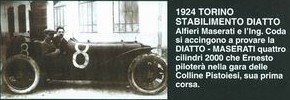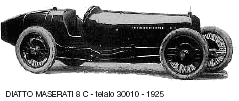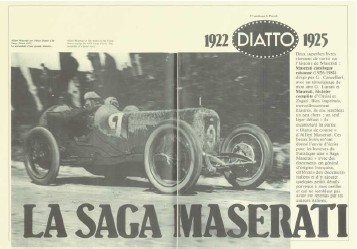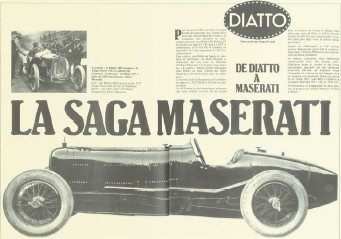DIATTO - MASERATI
![]()
1922 - 1926 : Diatto – Maserati :
from the
Diatto race team to the foundation of Maserati
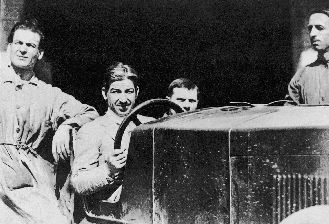 |
|
1923 Maserati in a 2 litre Diatto |
At the beginning of the Twenties, Alfieri and Ernesto Maserati were highly sought after for their skills, both as drivers and designers.
Diatto believed in their talent and brought them in to direct the Race Team in 1922, winning against numerous other offers, thus launching a long period of fruitful collaboration in automotive design and race victories.
Alfieri Maserati, with a Diatto 3000, took first place in November 1922 at the Monza Autodrome, winning the Gran Premio d’Autunno - 400 km, at an average speed of 125 kph, with the renowned Ugo Sivocci in his Alfa Romeo 3000 bringing up the rear.
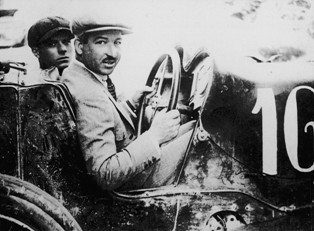 |
|
1924 Maserati/Parenti in a 3 litre Diatto |
This was the first of a series of important wins, on track and road, like the very challenging Parma - Poggio di Berceto and Aosta - Gran San Bernardo uphill time trials, victories which were repeated for two years in a row.
The Maserati brothers, absorbed in their prestigious work for Diatto, were by now living in Turin to design, test and race their Diatto race cars. In 1923, Coda, the Diatto director and designer, made two experimental 8 cylinder, 4 litre, inline engines, by coupling together two Diatto Tipo 20 series production engine blocks. Between 1924 and 1925, Alfieri Maserati, under the guidance of Coda, whom he called “my master”, developed the prototypes into a new Diatto engine with total displacement reduced to 1995 cc.
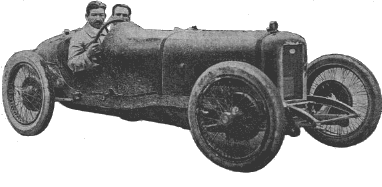 |
|
1925 Monza - G.P. d’Italia - |
This was the first 8C Diatto engine built by Maserati, with inline single block aluminium engine, with two shafts, two Memini carburettors and Roots compressor; a design which was so successful that when Maserati founded his own company, he used it and achieved victories in it for many years.
Thus the legendary 8C Diatto Grand Prix compressor -160 HP- with Schieppati bodywork was born. The car was unveiled by Maserati at Monza on 14 June 1925, at the foundation of the famous “100 kph club” founded by Diatto supporters.
 Maserati drove a number of demonstration laps and reached 180 km/h to the enthusiasm of the crowd.
Subsequently, he delivered a second 8 cylinder engine to Diatto and, with the mediation of Coda, kept the prototype as payment for the work done over the years without payment – just like Coda himself.
Maserati drove a number of demonstration laps and reached 180 km/h to the enthusiasm of the crowd.
Subsequently, he delivered a second 8 cylinder engine to Diatto and, with the mediation of Coda, kept the prototype as payment for the work done over the years without payment – just like Coda himself.
Despite the fact that Diatto was winning races and selling cars, and had a prosperous portfolio of orders, the company finances were in a sorry state due to the failure of the Kingdom of Italy to pay for its wartime supplies.
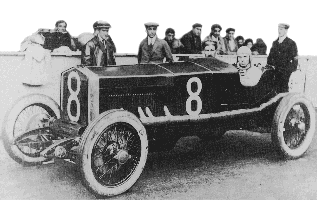 |
|
1924 - G.P. San Sebastian (Spain) |
For Maserati, there was no lack of success, admiration and temptations. The champion Franz Conelli, who was a friend of Bugatti, convinced Maserati to install the Diatto 8C engine on his victorious Diatto-Bugatti racing car. The Marquis driver Diego De Sterlich offered a new body, painted light blue for the occasion (the typical Bugatti colour), to promote the idea of a collaboration with Bugatti, the attempt was in vain.
Maserati remained with Diatto, crowning his glorious racing career on the podium of the Targa e Coppa Florio, at the Cremona racetrack, at the Coppa della Consuma, the Susa - Moncenisio, in the Pistoia hills.
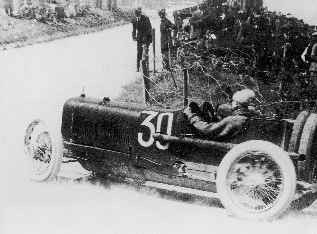 |
|
1923 - Parma-Poggio di Berceto Maserati in a Diatto 20 S |
At the beginning of 1926, when Diatto officially withdrew from competition, Diego De Sterlich, an admirer of the Maserati brothers, bought ten Tipo 30 sports chassis from Diatto, along with their gearboxes and numerous mechanical parts. He had them delivered to Alfieri Maserati, and convinced him to start his own racing car company, partly financing the new venture.
With these Diatto Tipo 30 fully equipped sport chassis, with the enormous technical and sporting inheritance of the Diatto Race Team, Alfieri and Ernesto Maserati founded the new company with the Trident logo: Maserati. The first Maserati cars, with their Diatto engines, are numbered from 011 onwards.
This was the eleventh of the engines previously designed and manufactured by Alfieri Maserati for Diatto race cars, engines implanted on request by either Diatto or directly by Maserati:
DIATTO 4 Cylinders:
20S/2000; 20H-S/6000; 23S/2300; 26S/2600; 30S/300; 35SS/3500;
DIA
TTO 8 Cylinders :
20SSMB/2000; 40MM/4000;
40BTS/4000; 40BTF/4000;
MASERATI 8 Cylinders:
TIPO 26: MB/1500.
|
|
|
At the 1926 “Targa Florio”, Maserati was registered with a Diatto 2 litre 8C Grand Prix compressor. But he actually competed with his first Maserati “Tipo 26”, a modified Diatto Grand Prix, with engine reduced from 2000 to 1500 cc, to meet the restrictions of the new international regulations. The Diatto Grand Prix cars, further developed under the auspices of the Maserati trident, were winners for many years to come, thus attesting their design and technological superiority (see the website for the original Diatto-Maserati documents). Many gentleman drivers, when Diatto ceased production in the early Thirties, brought their Diatto race cars, still excellent competitors, to the Maserati brothers.
|
|
|
|
|
|






